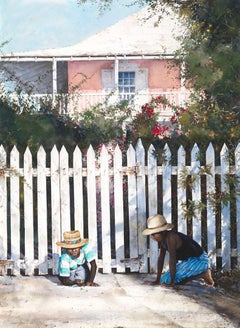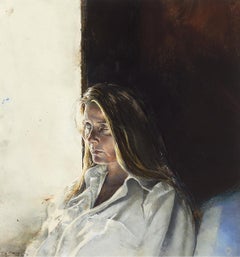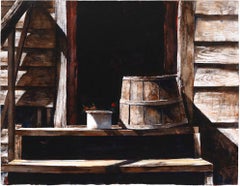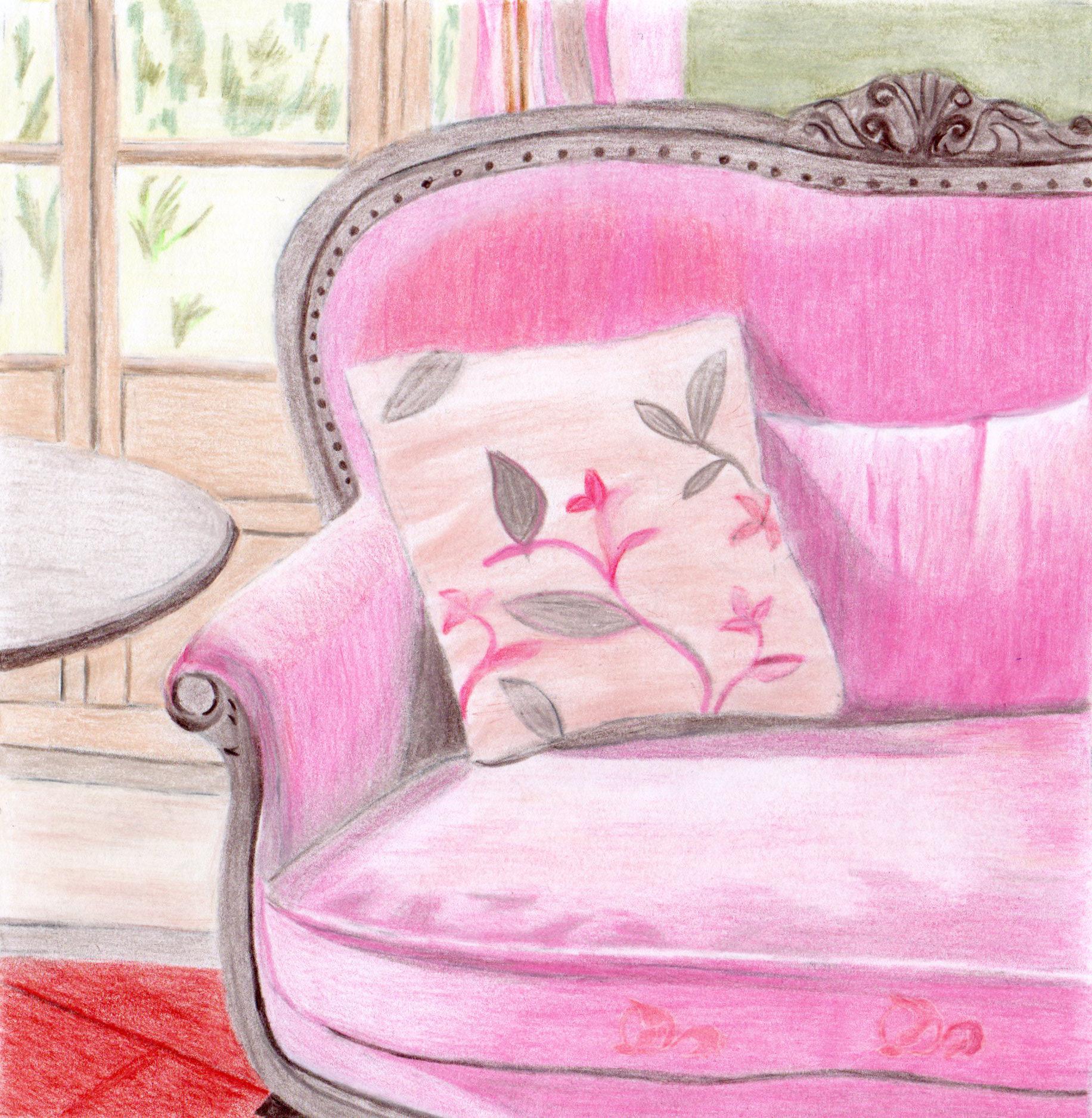Stephen Scott Young Drawings and Watercolor Paintings
American, b. 1957
Stephen Scott Young [1957 - ] American
Young was influenced by artists such as Winslow Homer and the Old Masters such as Caravaggio and Vermeer. A graduate of the Ringling School of Art in Sarasota, Florida, Young began working in watercolor in 1976 taking first prize at the American Artists national art competition in watercolors in 1985. Like Homer, Young made trips to the Bahamas where he discovered the crisp, bright light that has become the hallmark of his paintings today. Both painted beautifully detailed figurative works which included black girls. Currently, the artist divides his time between studios in Florida and the Bahamas. He is part of the contemporary American Realist movement.
(Biography provided by Lost Art Gallery)
to
5
3
3
2
3
1
1
Overall Height
to
Overall Width
to
1
3
3
2
2
2
2
1
1
1
1
1
1
1
1
1
3
2
2
1
8
705
408
288
228
5
5
2
1
1
Artist: Stephen Scott Young
Miss Ruby's: Daufuskie Island
By Stephen Scott Young
Located in New York, NY
Signed at lower left: SSYoung
Inscribed at lower right: Daufuskie Island
The artistʼs inscription on the verso side of this work reads:
Miss Rubyʼs farm on the Gullah Island of Da...
Category
Early 2000s Stephen Scott Young Drawings and Watercolor Paintings
Materials
Watercolor
Island Games (Lucky Shot)
By Stephen Scott Young
Located in New York, NY
Image dimensions: 29 ¼ x 21 ½ inches
Framed dimensions: 45 x 37 inches
Signed and dated at lower left: SSYoung / 99'
Island Games (Lucky Shot) depicts a pair of young Bahamian boys engaged in a game of marbles, one of the artist's signature themes. Scholar William Gerdts writes:
In these works, Scott not only depicts young individuals engaging in a popular activity but shows their intensity and competitiveness while conveying their camaraderie. The pictures are not so much about "winners" and "losers" as about the boys' concentration on the game and the interest shown by onlookers....The sense of community evoked in the series suggests that playing marbles...
Category
1990s American Realist Stephen Scott Young Drawings and Watercolor Paintings
Materials
Watercolor, Gouache, Archival Paper
The Captain's Lady. style of Andrew Wyeth
By Stephen Scott Young
Located in Miami, FL
This meticulously rendered work depicts a three-quarter view of a young woman lost in deep introspection.
Inscribed on verso: " The Captain's Lady"
Leslie of ____________ St. ...
Category
1980s American Realist Stephen Scott Young Drawings and Watercolor Paintings
Materials
Watercolor
Miss Ruby's Flowers
By Stephen Scott Young
Located in New York, NY
Image dimensions: 17 x 22 inches
Framed dimensions: 27 x 32 inches
The artistʼs inscription on the verso side of this work reads:
What amazed me about being on Daufuskie at Miss Ru...
Category
21st Century and Contemporary Contemporary Stephen Scott Young Drawings and Watercolor Paintings
Materials
Watercolor, Handmade Paper
The Captain's Lady
By Stephen Scott Young
Located in Miami, FL
This meticulously rendered work depicts a three-quarter view of a young woman lost in deep introspection.
Inscribed on verso: " The Captain's Lady"
Leslie of ____________ St. ...
Category
1980s American Realist Stephen Scott Young Drawings and Watercolor Paintings
Materials
Watercolor
Related Items
The Abduction of the Sabine Women , a Renaissance drawing by Biagio Pupini
Located in PARIS, FR
This vigorous drawing has long been attributed to Polidoro da Caravaggio: The Abduction of the Sabine Women is one of the scenes that Polidoro depicted between 1525 and 1527 on the façade of the Milesi Palazzo in Rome. However, the proximity to another drawing inspired by this same façade, kept at the Ecole des Beaux-Arts, and to other drawings inspired by Polidoro kept at the Musée du Louvre, leads us to propose an attribution to Biagio Pupini, a Bolognese artist whose life remains barely known, despite the abundant number of drawings attributed to him.
1. Biagio Pupini, a Bolognese artist in the light of the Roman Renaissance
The early life of Biagio Pupini, an important figure of the first half of the Cinquecento in Bologna - Vasari mentions him several times - is still poorly known. Neither his date of birth (probably around 1490-1495) nor his training are known. He is said to have been a pupil of Francesco Francia (1450 - 1517) and his name appears for the first time in 1511 in a contract with the painter Bagnacavallo (c. 1484 - 1542) for the frescoes of a church in Faenza. He then collaborated with Girolamo da Carpi, at San Michele in Bosco and at the villa of Belriguardo.
He must have gone to Rome for the first time with Bagnacavallo between 1511 and 1519. There he discovered the art of Raphael, with whom he might have worked, and that of Polidoro da Caravaggio. This first visit, and those that followed, were the occasion for an intense study of ancient and modern art, as illustrated by his abundant graphic production.
Polidoro da Caravaggio had a particular influence on the technique adopted by Pupini. Executed on coloured paper, his drawings generally combine pen, brown ink and wash with abundant highlights of white gouache, as in the drawing presented here.
2. The Abduction of the Sabine Women
Our drawing is an adaptation of a fresco painted between 1525 and 1527 by Polidoro da Caravaggio on the façade of the Milesi Palace in Rome. These painted façades were very famous from the moment they were painted and inspired many artists during their stay in Rome. These frescoes are now very deteriorated and difficult to see, as the palace is in a rather narrow street.
The episode of the abduction of the Sabine women (which appears in the centre of the photo above) is a historical theme that goes back to the origins of Rome and is recounted both by Titus Livius (Ab Urbe condita I,13), by Ovid (Fasti III, 199-228) and by Plutarch (II, Romulus 14-19). After killing his twin brother Romus, Romulus populates the city of Rome by opening it up to refugees and brigands and finds himself with an excess of men. Because of their reputation, none of the inhabitants of the neighbouring cities want to give them their daughters in marriage. The Romans then decide to invite their Sabine neighbours to a great feast during which they slaughter the Sabines and kidnap their daughters.
The engraving made by Giovanni Battista Gallestruzzi (1618 - 1677) around 1656-1658 gives us a good understanding of the Polidoro fresco, allowing us to see how Biagio Pupini reworked the scene to extract this dynamic group.
With a remarkable economy of means, Biagio Pupini takes over the left-hand side of the fresco and depicts in a very dense space two main groups, each consisting of a Roman and a Sabine, completed by a group of three soldiers in the background (which seems to differ quite significantly from Polidoro's composition).
The balance of the drawing is based on a very strongly structured composition. The drawing is organised around a median vertical axis, which runs along both the elbow of the kidnapped Sabine on the left and the foot of her captor, and the two main diagonals, reinforced by four secondary diagonals. This diamond-shaped structure creates an extremely dynamic space, in which centripetal movements (the legs of the Sabine on the right, the arm of the soldier on the back at the top right) and centrifugal movements (the arm of the kidnapper on the left and the legs of the Sabine he is carrying away, the arm of the Sabine on the right) oppose each other, giving the drawing the appearance of a whirlpool around a central point of support situated slightly to the left of the navel of the kidnapper on the right.
3. Polidoro da Caravaggio, and the decorations of Roman palaces
Polidoro da Caravaggio was a paradoxical artist who entered Raphael's (1483 - 1520) workshop at a very young age, when he oversaw the Lodges in the Vatican. Most of his Roman work, which was the peak of his career, has disappeared, as he specialised in facade painting, and yet these paintings, which are eminently visible in urban spaces, have influenced generations of artists who copied them abundantly during their visits to Rome.
Polidoro Caldara was born in Caravaggio around 1495-1500 (the birthplace of Michelangelo Merisi, known as Caravaggio, who was born there in 1571), some forty kilometres east of Milan. According to Vasari, he arrived as a mason on the Vatican's construction site and joined Raphael's workshop around 1517 (at the age of eighteen according to Vasari). This integration would have allowed Polidoro to work not only on the frescoes of the Lodges, but also on some of the frescoes of the Chambers, as well as on the flat of Cardinal Bibiena in the Vatican.
After Raphael's death in 1520, Polidoro worked first with Perin del Vaga before joining forces with Maturino of Florence (1490 - 1528), whom he had also known in Raphael's workshop. Together they specialised in the painting of palace façades. They were to produce some forty façades decorated with grisaille paintings imitating antique bas-reliefs.
The Sack of Rome in 1527, during which his friend Maturino was killed, led Polidoro to flee first to Naples (where he had already stayed in 1523), then to Messina. It was while he was preparing his return to the peninsula that he was murdered by one of his assistants, Tonno Calabrese, in 1543.
In his Vite, Vasari celebrated Polidoro as the greatest façade decorator of his time, noting that "there is no flat, palace, garden or villa in Rome that does not contain a work by Polidoro". Polidoro's facade decorations, most of which have disappeared as they were displayed in the open air, constitute the most important lost chapter of Roman art of the Cinquecento. The few surviving drawings of the painter can, however, give an idea of the original appearance of his murals and show that he was an artist of remarkable and highly original genius.
4. The façade of the Milesi Palace
Giovanni Antonio Milesi, who commissioned this palace, located not far from the Tiber, north of Piazza Navona, was a native of the Bergamo area, like Polidoro, with whom he maintained close friendly ties. Executed in the last years before the Sack of Rome, around 1526-1527, the decoration of Palazzo Milesi is considered Polidoro's greatest decorative success.
An engraving by Ernesto Maccari made at the end of the nineteenth century allows us to understand the general balance of this façade, which was still well preserved at the time. The frescoes were not entirely monochrome, but alternated elements in chiaroscuro simulating marble bas-reliefs and those in ochre simulating bronze and gold vases...
Category
16th Century Old Masters Stephen Scott Young Drawings and Watercolor Paintings
Materials
Ink, Gouache, Pen
Intérieur Provence, Realistic Figurative original Drawing, Colorful, Interior
Located in AIX-EN-PROVENCE, FR
Coloured Pencils and pastel on Hahnemühle paper - Realistic Figurative original Drawing, Colorful, Interior.
Work Title : Intérieur Provence
Artist : Gabriel Riesnert...
Category
21st Century and Contemporary Contemporary Stephen Scott Young Drawings and Watercolor Paintings
Materials
Watercolor, Archival Paper, Color Pencil, Pastel
H 6.3 in W 5.91 in D 0.08 in
Nag Arnoldi , Switzerland - Drawings (1974) : Falling Icarus and Crouching Angel
By Nag Arnoldi
Located in Meinisberg, CH
Nag Arnoldi
(Swiss, * 18.9.1928 Locarno, † 10.2.2017 Lugano)
1. Falling Icarus
• Drawing - Mixed media (Indian ink, coloured pencil & gouache) on paper ca. 22 x 26 cm
• Signiert & ...
Category
Late 20th Century Abstract Expressionist Stephen Scott Young Drawings and Watercolor Paintings
Materials
Paper, India Ink, Gouache
Free Shipping
H 8.67 in W 10.24 in D 0.4 in
Judaica Pastel Portrait Rabbi Painting WPA Era Artist, Social Realist
By Bernard Gussow
Located in Surfside, FL
Bernard Gussow 1881 -1957
Bernard Gussow was active/lived in New York, New Jersey / Russian Federation. Bernard Gussow is known for genre, landscape, figure, interior paintings.
Ber...
Category
1940s American Realist Stephen Scott Young Drawings and Watercolor Paintings
Materials
Oil Pastel
Gustav Melcher ( German, 1898 -?) Boats off Venice Italy Ink Water Color c. 1918
By Gustav Melcher
Located in Meinisberg, CH
Gustav Melcher
(German, 1898-?)
Segelschiffe vor Venedig - Sailing ships off Venice
• India ink, water colour wash
• Visible image ca. 11.5 x 18 cm
• Glased Frame ca. 20 x 25 cm
• Verso various inscriptions
• Signed lower right
Gustav Melcher was a German painter and a pioneer in film, film criticism and film theory and created this clever little picture of the skyline of Venice with various vessels.
Going by the various inscriptions an the backing paper, this drawing was made in 1918 when Gustav was twenty years old and passed on three years later to Gertrud Melcher on the 1. 2. 1921. I have no reasons to doubt this information. The small drawing is still in its unopened frame, so maybe there is more information to be discovered , however this will be the privilege of the next owner.
The picture also has retained its original antique frame – note that it has lost over the years various sections of the gesso decoration.
The very precisely executed drawing is most enjoyable to look at and doing so, remember you are looking through the eyes of a young man, who saw this foreign sea cape over a century ago.
Thank you for your interest and please note, that I offer free worldwide shipping on all my items.
Gustav Melcher began his studies at the Düsseldorfer Kunstakademie under Peter Janssen and Eduard von Gebhardt. Originaly he was interested in figurative and portrait painting, but after time he decided to pursue the depiction of land- and marinescapes. Durin his studies the young artist undertook trips to visit England, Scotland, Belgium and France and he joined the artist society Malkasten. It was in those days he would hold speeches to his colleges about this new invention called ‘Kintopp’ – Melcher was a great advocate of the moving pictures...
Category
1910s Naturalistic Stephen Scott Young Drawings and Watercolor Paintings
Materials
India Ink, Paper, Watercolor
Gustav MelcherGustav Melcher ( German, 1898 -?) Boats off Venice Italy Ink Water Color c. 1918, 1918
Free Shipping
H 7.88 in W 9.85 in D 0.79 in
Furniture designer and architeFinn Juhl’s home. Watercolor and gouache on paper.
By Manuel Santelices
Located in Miami Beach, FL
Finn Juhl’s home, by Manuel Santelices
Watercolor and gouache on paper
Image size: 8 in. H x 11 in. W
Unframed
2021
The worlds of fashion, society, and pop culture are explored th...
Category
21st Century and Contemporary Contemporary Stephen Scott Young Drawings and Watercolor Paintings
Materials
Watercolor, Gouache, Paper
Art Deco Fashion Illustration Ink and Gouache Drawing by Edouard Halouze
Located in Atlanta, GA
This is an Art Deco original illustration drawing, hand-painted with ink and gouache on paper, designed by French artist Edouard Halouze. The artwork features two stylish female mode...
Category
1920s Art Deco Stephen Scott Young Drawings and Watercolor Paintings
Materials
Ink, Gouache
H 14.18 in W 12.01 in D 1.97 in
Still Life at a Table, Study in Yellow by Artist Harold Haydon
By Harold Haydon
Located in Chicago, IL
A ca. 1931 delightful watercolor still life at a table; a study in yellow by artist Harold Haydon.
Harold Emerson Haydon was born in Fort William, Ont...
Category
1930s American Modern Stephen Scott Young Drawings and Watercolor Paintings
Materials
Paper, Ink, Watercolor, Pen
Freya (Seated Backwards), Mixed media on grey board
By Howard Tangye
Located in London, GB
Howard Tangye (b.1948, Australia) has been an influential force in fashion for decades. Lecturing at London’s Central Saint Martins for 35 years, including 16 years as head of BA Wom...
Category
2010s Contemporary Stephen Scott Young Drawings and Watercolor Paintings
Materials
Other Medium, Archival Paper, Handmade Paper, Pen, Felt Pen, Permanent M...
Thomas Heathfield Carrick, Miniature portrait of a gentleman
By Thomas Heathfield Carrick
Located in Harkstead, GB
A very delicately painted portrait miniature on marble of a distinguished looking gentleman. Superb detail and colour - a very striking piece and a rare example of a work by this fir...
Category
Mid-19th Century Victorian Stephen Scott Young Drawings and Watercolor Paintings
Materials
Marble
Free Shipping
H 5.5 in W 4.5 in D 1.5 in
Vexing (Framed)
By Paul Pitsker
Located in Fairfield, CT
"My watercolor paintings depict narrative dilemmas, light-hearted vignettes, or staged existential dramas on a microcosmic scale, as they might be seen through a shallow focus lens. ...
Category
2010s Stephen Scott Young Drawings and Watercolor Paintings
Materials
Paper, Watercolor
Chicago Jewish Modernist Judaica Painting Simchat Torah WPA Artist Israeli Flags
By Alexander Raymond Katz
Located in Surfside, FL
This has young ISraeli pioneers dancing with the flag as typical of works of the late British mandate Palestine era early state of Israel.
Genre: Modern
Subject: Figurative (stained glass style)
Medium: Mixed media gouache on paper
Hand signed lower left
Alexander Raymond Katz, Hungarian / American (1895 – 1974)
Alexander Raymond Katz was born in Kassa, Hungary, and came to the United States in 1909. He studied at the Art Institute of Chicago and the Chicago Academy of Fine Arts. In the late 1920s, he worked as a director of the Poster Department at Paramount Studios. He was appointed the Director of Posters for the Chicago Civic Opera in 1930.
During the Great Depression, notable architect Frank Lloyd Wright urged Katz to become a muralist. In 1933, he was commissioned to paint a mural for the Century of Progress exposition in Chicago. In 1936, he painted the mural History of the Immigrant for the Madison, Ill., post office. Katz’s works were included in various exhibitions and now are part of several museum collections, including those of the Art Institute of Chicago; Corcoran Gallery of Art, Washington, D.C.; and the Jewish Museum, New York. His murals, bas-reliefs and stained glass designs adorn more than 200 Jewish synagogues in the United States.
Katz and other Jewish artists in Chicago who expressed Jewish and Biblical themes were inspired by the artist Abel Pann (1883-1963). Pann, who is regarded as the leading painter of the Land of Israel, exhibited in the Art Institute of Chicago in 1920.
Early in his career, Katz began to explore the artistic possibilities inherent in the characters of the Hebrew alphabet. He developed aesthetic and philosophical interpretations of each letter and became the leading innovator and pioneer in the field of Hebraic art.
Katz applies this concept in the woodcut Moses and the Burning Bush. Hebrew letters appears in Moses’ head, his cane and inside the flame. The initial of Moses’ name crowns his head. The letter in the flame is the first letter of the name of God. A combination of images and Hebrew letters appeared commonly in illustrations of the scene Moses and the Burning Bush in the Haggadah, the book of Passover.
The symbolism of the burning bush corresponds to the motifs of A Gift to Biro-Bidjan. Among the fourteen participating artists were notable Chicago modernists Todros Geller, Mitchell Siporin...
Category
Mid-20th Century Modern Stephen Scott Young Drawings and Watercolor Paintings
Materials
Paper, Gouache
Stephen Scott Young drawings and watercolor paintings for sale on 1stDibs.
Find a wide variety of authentic Stephen Scott Young drawings and watercolor paintings available for sale on 1stDibs. You can also browse by medium to find art by Stephen Scott Young in paint, watercolor, paper and more. Much of the original work by this artist or collective was created during the 20th century and is mostly associated with the contemporary style. Not every interior allows for large Stephen Scott Young drawings and watercolor paintings, so small editions measuring 15 inches across are available. Customers who are interested in this artist might also find the work of Thomas Strickland, Leon Kroll, and Don David. Stephen Scott Young drawings and watercolor paintings prices can differ depending upon medium, time period and other attributes. On 1stDibs, the price for these items starts at $60,000 and tops out at $85,000, while the average work can sell for $63,500.






